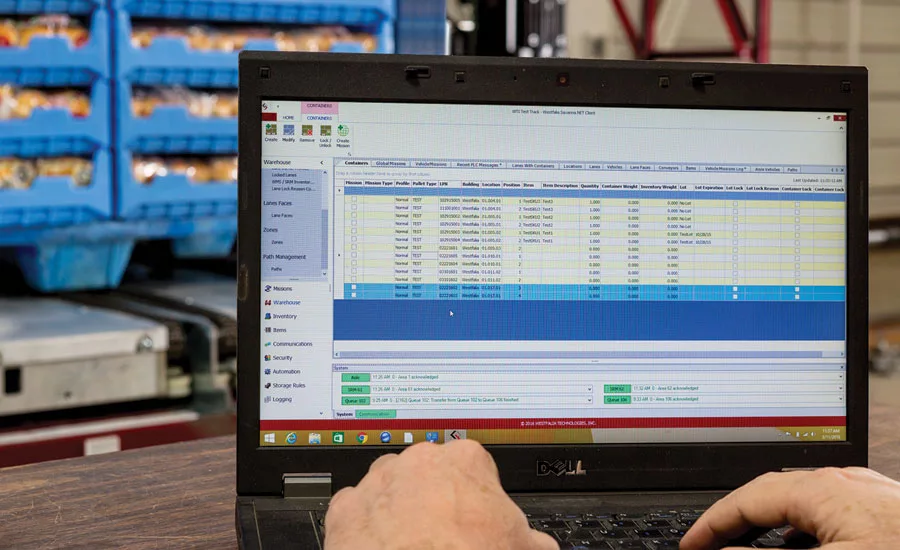Beverage warehouse turn to software to reduce costs, boost throughput
Warehouse execution systems combine WMS and WCS capabilities


Before the adaption of WYSIWG, the acronym for what you see is what you get, printed documents, web pages and slide presentations required users to have in-depth knowledge of codes and markup tags. But, through the use of these system editors, communicating a product’s layout has simplified the process and opened the execution to those who might not possess advanced coding knowledge. As warehouse operations become more complex, software companies also are advancing their programs to ensure plant managers can benefit from that same ease of execution.
“A best-of-breed warehouse management system will result in near-perfect inventory accuracy and allow for complete traceability of all products,” says Jon Kuerschner, vice president of product management and consulting for Highjump Software, Minneapolis. “This visibility is crucial if, for example, a recall is ordered. Inventory accuracy will increase the productivity of warehouse employees because there is no time wasted looking for missing product or finding the next task. Workflow is optimized to minimize travel and maximize tasks. In addition, when customers consistently receive their orders on time and in full, it leads to the loyalty that facilitates long-term success.”
Digging deeper into inventory traceability and accuracy, software designers increasingly are developing programs that focus on product flows.
“Warehouse management systems (WMS) have typically been focused on the overarching management of warehouses and distribution centers,” says Ryan Herrygers, senior product manager for Intelligrated, Mason, Ohio. “Warehouse control system (WCS) software was typically the interface to automation and machines within the four walls of the warehouse. As the demand for greater speed and efficiency has risen, it exposed a gap between the higher-level WMS and lower-level WCS.
“This is where warehouse execution systems (WES) fill a need,” he continues. “WES is introducing software to the market that has all the capabilities of a typical WCS system with increased intelligence around work execution, machine intelligence, as well as advanced labor and resource management.”
Dave Williams, director of software and solutions delivery for Westfalia Technologies Inc., York, Pa., also notes how WES combines the directives of WMS and WCS operations for more simplified communications.
“A warehouse execution system combines a tightly integrated warehouse management system and warehouse control system into a single application to help manufacturers and distributors direct, control and optimize internal material flow and order picking,” he explains. “This two-in-one method utilizes one single system to perform the tasks of both a WMS and a WCS. The WES technology simplifies communication and controls, and exchanges are not complicated by duplicated data or controls. With its modular capability, a WES enables companies of all sizes to select only the modules they need to handle their warehousing processes.”
David Schwebel, senior director of business development and management for Newport News, Va.-based Swisslog, explains that a WMS operates like a control tower for a network of warehouses, whereas a WES should be thought of as an onsite director for an individual warehouse.
“It’s very focused,” Schwebel says of a WES program. “It is a traffic director, if you will, and it specializes in being the traffic director — slotting, inventory management, cross docking, putting away, all those different versions of weight picking and weightless picking, making certain that your resources are consumed properly and the resources being both labor, a supervisor as well as a resource being of material handling equipment, like your forklifts even down to the scrubbers needed — a WES is great in that regard.”
He adds that the flexibility of WES operations allows orders to be easily amended — whether it be the business unit, business user or supplier partner. “WES is more robust around making changes specific in a distribution based on the environment, based on the culture, based on the people,” Schwebel says.
Growing assortment
Although a collection of trends have contributed to beverage warehouses investing in software programs, SKU proliferation is one to which many experts call attention.
“As the beverage industry continues to grow and generate more SKUs, manufacturers and distributors are seeking new ways to operate more efficiently, improve customer satisfaction and cut costs. Using a warehouse execution system helps direct, control and optimize internal material flow and order picking throughout the warehouse,” Westfalia’s Williams says. “As a result, beverage-makers and distributors are able to better meet the growing demand, while raising productivity, lowering risks, boosting throughput, increasing inventory accuracy and enhancing customer satisfaction.”
As SKU proliferation continues to impact beverage warehouses, software providers are fine-tuning their products to accommodate the growing set of demands.
Intelligrated’s Herrygers explains that some of the impacts that beverage-makers and distributors are experiencing from SKU proliferation include a lower demand for unique items, which increase the cost-to-carry inventory; space utilization algorithms to accommodate new products, which have created complexity for older software systems; deciding when and where to source the product from within the warehouse; and reduced productivity because of storage and fulfillment processing.
“WMS systems have been required to extend functionality and become more intelligent on supply chain demand visibility and profiling for the warehouse,” he says. “Inventory tracking and space utilization within the four walls has become more complex and require the WES to develop specific approaches to handle storage and fulfillment.”
In addition to a larger number of SKUs, beverage warehouses also have seen an influx of unique packages. Swisslog’s Schwebel notes that this can have a significant impact on software programs.
“The interesting thing is control software cares about the package conventions measurably,” he says. “It is quite possible to purchase a package that doesn’t work well with your control system or doesn’t work well with the hardware.”
For example, liquid concentrate bottles, as well as their secondary packaging for the display sets, might not work as easily in existing warehouse operations, Schwebel notes.
“The sellable case to the customer is rather small,” he explains. “When you previously configured your conveyor, your sortation equipment [and] your picking equipment to handle a certain set of package that is sometimes five to six times the size of those drops to begin with, you can’t move those drops easily through your warehouse control system. The system doesn’t know what to do because it’s too small to handle.”
However, an increasing number of SKUs are not the only trend impacting warehouse operations. “The emergence of new distribution channels like direct-to-consumer and buy online, pickup in-store have complicated warehouse operations,” Highjump’s Kuerschner says. “Companies must invest in technology to successfully manage the different channels and capitalize on the opportunity, especially in today’s ultra-competitive environment. There is growing awareness about the tremendous benefits that come with implementing a WMS — younger companies are investing in it based on projected growth rather than current revenue.”
Intelligrated’s Herrygers echoes similar sentiments: “Omnichannel fulfillment is changing the profile of the supply chain. The ability to connect directly to consumers from the warehouse is a likely evolution for beverage suppliers. The rise in online grocery services is a prime example of this. Direct-to-consumer shipments from the warehouse are a pattern that will ripple across every industry. This means concepts like distributed order management (DOM) and continuous order flow within the four walls will soon penetrate the beverage market space.”
Regardless of which beverage or channel trend next emerges, software providers recognize the value of adopting flexible systems to support the evolving warehouse.
“WES applications will continue to play a key role in the reduction of costs at the warehouse level of the supply chain,” Westfalia’s Williams says. “By optimizing product receipt, storage, tracking and retrieval, as well as driving efficiencies throughout the order fulfillment process, these integrated applications will help companies deliver their products in a more cost-effective manner.” BI
Looking for a reprint of this article?
From high-res PDFs to custom plaques, order your copy today!







